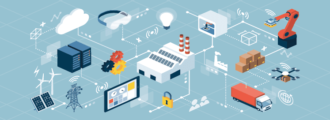Manufacturers and distributors face a unique set of challenges in the market that requires a different set of technology solutions. They must manage materials and inventory, plan procurement, schedule production activities, and more.
On top of that, the recent landscape has also shifted dramatically with the adoption of the Internet of Things (IoT). This revolution, known as Industry 4.0, has caused manufacturers to adopt new digital solutions to address the complex landscape.
This post breaks down ERP vs. MRP, looking at the key differences and how these technologies can best support your manufacturing operations and improve business processes. Let’s get started.
Understanding ERP vs. MRP
The most commonly used tools for manufacturers and distributors are Enterprise Resource Planning (ERP) and Manufacturing Resource Planning (MRP) solutions. These tools can often be misunderstood in their role in the manufacturing industry. While there are differences between the two solutions, there are ways to integrate these modern tools to help streamline supply chain management, improve customer satisfaction, and increase profits.
What is Enterprise Resource Planning?
An enterprise resource planning system (also known as an ERP system) helps organizations plan, manage, and automate operational processes across different departments. Businesses of all sizes and industries utilize ERP software to facilitate project management, supply chain management, human resources, finances, manufacturing, and more. ERP systems handle the flow of data and information between different sources, helping companies budget, plan, forecast, and report on various business tasks.
The most popular ERP software on the market is JD Edwards, SAP, Infor, Workday, and Microsoft Dynamics.
ERP systems were made for every industry, not just manufacturing. However, to help address the needs of manufacturers and distributors, many companies integrate ERP and MRP systems to leverage the power of both for enhanced manufacturing operations.
What is Manufacturing Resource Planning?
MRP systems manage all manufacturing processes, including identifying materials, estimating quantities, planning the production schedule, and delivery. It’s important to note that people often use the acronym MRP to describe MRP I and MRP II.
MRP II software is the next generation of material requirement planning systems because it includes employee and financial information. The goal of an MRP system is to enhance production planning and improve operational costs.
You can distinguish the two software systems by their functions. ERPs manage high-level business data and work streams, while MRP systems control manufacturing processes like capacity planning, materials management, inventory management, change management, product scheduling, and supply chain management. MRP systems can lower operational costs by demand forecasting — ensuring the right materials from the right suppliers meet the scheduled production timeline.
Smaller manufacturers typically use MRP systems as standalone systems. This can be a good cost-saving measure for companies with small budgets, but the problem comes when organizations need to scale. This is where ERP systems come in. Integrating an MRP module into your ERP solution can help your manufacturing business automate processes and scale for growth.
Benefits of ERP Solutions
Now, let’s explore the benefits of ERP vs. MRP. Here are the top benefits that companies using ERP software experience:
- Enhanced collaboration — ERP systems unify data across teams and departments into one unified platform.
- Improved business operations — ERPs manage many business processes, making the company more efficient.
- Better customer service — Many ERPs come with customer relationship management features that give you access to customer data to improve the customer service experience.
- Increased visibility — An ERP system gives you a complete picture of your business operations and data in one system.
- Cost savings — An ERP system can help you eliminate manual processes and administrative tasks, allowing you to shift those resources to more strategic business projects.
Benefits of MRP Systems
Now, onto the benefits of an MRP system, which include:
- Comprehensive production planning — MRP systems let manufacturers plan for labor, equipment, material, and other necessary resources for a smooth production process and better quality assurance.
- Better purchase planning — With more visibility into the business, manufacturers can improve forecasting and purchase planning.
- Inventory control — An MRP system gives manufacturing companies access to real-time information to better accurately control inventory and ensure they never run low on supplies or raw materials.
- Improved data management — Manufacturers collect massive amounts of data. With an MRP system, you can better manage and use that data to make more informed business decisions across the organization.
It’s Not Always ERP vs. MRP: Top Reasons for Integrating
Instead of thinking of either an ERP or MRP system, you might want to consider ERP and MRP systems. There are many reasons for integrating MRP and ERP systems. Here are the top three reasons why you should consider it.
Streamline Business Operations
Manufacturers are constantly balancing supply and demand. But in today’s world, managing operations on a spreadsheet will no longer cut it. You need automated tools that can help you scale operations and grow the business.
With ERP and MRP systems together, you can automatically calculate quantities and dates for purchase orders. You’ll have a complete record of all your transactions across the organization in one place. You can also give your vendors access to real-time order information to keep them informed and mitigate any order issues.
Stay Ahead of Demand
Manufacturers with multiple suppliers, products, vendors, and customers need a well-oiled supply chain to keep the train on the tracks. To do so, you need business software that delivers a complete picture of sales, orders, and everything in flight at the tip of your fingers.
ERP systems can give you real-time visibility to supply and demand so you can make informed business decisions when changes happen. By combining that data with an MRP system, you can deliver accurate forecasting for demand to minimize disruptions and maximize materials. These solutions can automate processes like converting quotes to orders, and even replenishing products as needed to help you stay ahead of ever-changing demand.
Exceed Customer Experiences
Customer service is a critical part of the manufacturing business. Today, customers’ expectations are at an all-time high. They want connected, personalized experiences with seamless communication at every stage of the buying process.
With a centralized system that combines your ERP and MRP solutions, you can not only meet—but exceed—those expectations. You can provide customers with real-time communications about orders and deliveries. And personalize the experience from buying to delivery. The customer experience directly affects your bottom line. Having the right tools in place to deliver those experiences is critical.
ERP and MRP Software Experts at Surety Systems
When it comes to MRP and ERP systems, it can be tough to distinguish between the two software solutions. They both handle similar functions in the manufacturing process.
The biggest difference comes down to their use case. MRP software is designed specifically for the manufacturing process. An ERP system is built for all businesses (including the manufacturing industry) and brings all your business data together.
How Can We Help?
If you’re trying to determine if your organization needs an ERP or MRP system (or both), the experts at Surety System can help.
Our senior-level consultants have experience with the latest software, including JD Edwards, SAP, Infor, Workday, Microsoft Dynamics, and other software systems.
Contact us today to learn about our broad range of services and how our industry experts can improve your business with the right tools.



